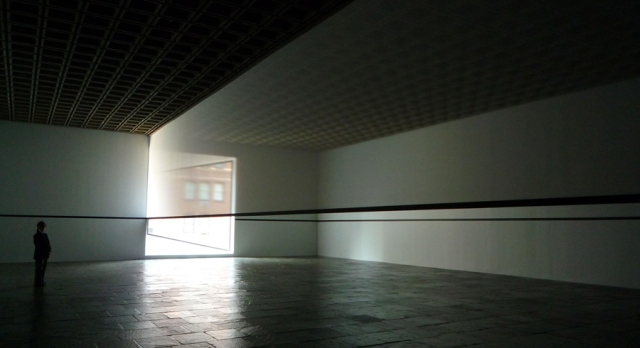check out the blog "SHIFTING CONNECTIONS"... Kathleen MacQueen
Source:http://shiftingconnections.com/2013/07/17/summer-shorts/

source
Robert Irwin: SCRIM VEIL—BLACK RECTANGLE—NATURAL LIGHT, WHITNEY MUSEUM OF AMERICAN ART, NEW YORK (1977)
The Whitney Museum of American Art
June 27 – September 1, 2013
W/Th/Sa/Su 11am-6pm; F 1-9pm
The Whitney Museum of American Art
June 27 – September 1, 2013
W/Th/Sa/Su 11am-6pm; F 1-9pm

Robert Irwin, Scrim Veil—Black Rectangle—Natural Light, Whitney Museum of American Art, New York (1977), 1977/2013. Photograph © 2013 Kathleen MacQueen.
There is no landscape that is not obscure,
underneath its pleasing transparencies, if you speak to it endlessly.
Édouard Glissant, “The Thinking of the Opacity of the World”
underneath its pleasing transparencies, if you speak to it endlessly.
Édouard Glissant, “The Thinking of the Opacity of the World”
That opacity is synchronous – not antithetical – to transparency is poetically intimated by Édouard Glissant[1] and luminously revealed by “Scrim Veil – Black Rectangle – Natural Light” Robert Irwin’s installation created for the fourth floor of the Whitney Museum in 1977 (and reinstalled this summer in anticipation of their move downtown in 2015). First reducing the space to its own architectural emphasis: in this case, the floor, grid pattern of Breuer’s honeycomb ceiling, and slanted window on the west wall, Irwin then adds precisely two elements to accentuate a third: a transparent scrim (“Scrim Veil”), aligned with the window recess and bisecting the rectangular room along its length, and horizon line (“Black Rectangle”), marking the circumference of the room in unison with the scrim, that is, approximately eye-level.
This sight line is critical, stabilizing our vision long enough to change expectation from seeing something to seeing anything: the third element of light (“Natural Light”) emanating from the window. Light hitting the scrim reveals the density of transparency when the veil acts not as “see through” but as a means to “see to” another space in time. Just as light’s twin is shadow, either one capable of provoking blindness or clarity, so too the veil alternates between transparency and opacity varying according to our position in relation to the light. This is a participatory space – there is little motivation to sit and meditate – yet movement is quiet, paced, and inquiring. Awareness shifts to peripheral aspects of the environment and to the threshold of thought between fixity and flexibility.
“The perceiving mind,” Merleau-Ponty reminds us, “is an incarnated mind.” And so we grasp external reality through perception but also feel its influence internally.[2] Time stretches into abundant patience, clutter falls away. Light washes across the wall in warm greys and mutes the act of seeing into a silent gathering of indefinable reverberation. Our world expands with an infusion of intimacy. This space of nearly nothing is more than enough for dialogue: it draws me to it. I am reluctant to leave – drifting within this light, these lines – this vision, rather than isolate and protect, reminds me I am one in a world among others, reticent in my relations, yes, but also resonant as being within space and across time, speaking endlessly to the horizon, through and into a gently rippled stillness.
[1] Thanks to Frieze editor Jennifer Allen for her decision to highlight this essay in the winter 2012 edition of the magazine. See Édouard Glissant, “The Thinking of the Opacity of the World,” chapter XI from Philosophie de la relation. Poésie en étendue (Philosophy of the Relation. Poetry in extension, 2009) translated from the French by Franck Loric, reprinted in Frieze d/e 7 (Winter 2012), 77.
[2] Maurice Merleau-Ponty (1964) The Primacy of Perception (Northwestern University Press), 3-5. We might consider this as “…the inside of the outside and the outside of the inside,” as he writes of art (164).

Comments